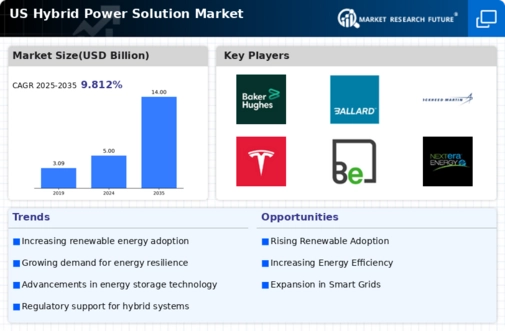Rising Energy Costs
the hybrid power-solution market is seeing a notable surge due to escalating energy costs in the US. As traditional energy prices continue to rise, consumers and businesses are increasingly seeking alternative solutions to mitigate expenses. The integration of hybrid systems, which combine renewable energy sources with conventional power, offers a viable pathway to reduce reliance on expensive grid electricity. In 2025, energy prices have risen by approximately 15% compared to previous years, prompting a shift towards more sustainable and cost-effective energy solutions. This trend is likely to drive investments in hybrid power technologies, as stakeholders recognize the potential for long-term savings and energy independence. Consequently, the hybrid power-solution market is positioned to benefit from this economic pressure, as more entities explore innovative energy strategies to manage costs.
Increased Demand for Energy Resilience
the hybrid power-solution market is seeing heightened demand for energy resilience, particularly in the face of natural disasters and grid instability. In recent years, the US has witnessed an increase in extreme weather events, leading to power outages and disruptions. As a result, both residential and commercial entities are seeking reliable energy solutions that can withstand such challenges. Hybrid systems, which combine multiple energy sources, offer enhanced reliability and flexibility, making them an attractive option for those prioritizing energy security. In 2025, it is estimated that the demand for resilient energy solutions will grow by 20%, further propelling the hybrid power-solution market. This trend underscores the importance of developing robust energy infrastructures that can adapt to changing environmental conditions and ensure continuous power supply.
Support from Private Sector Investments
the hybrid power-solution market is gaining from increased support from private sector investments, which are crucial for driving innovation and expansion. In 2025, private investments in renewable energy and hybrid technologies are projected to exceed $50 billion, reflecting a strong commitment to sustainable energy solutions. This influx of capital is enabling companies to develop and deploy advanced hybrid systems that cater to diverse energy needs. Furthermore, as investors recognize the potential for long-term returns in the hybrid power-solution market, competition is likely to intensify, leading to further advancements in technology and efficiency. The collaboration between private entities and public initiatives is expected to foster a conducive environment for growth, ultimately enhancing the market's capacity to meet the evolving energy demands of consumers and businesses alike.
Environmental Sustainability Initiatives
the hybrid power-solution market is greatly influenced by the growing emphasis on environmental sustainability in the US. As climate change concerns intensify, both consumers and corporations are increasingly prioritizing eco-friendly practices. The hybrid power-solution market provides a compelling alternative by reducing greenhouse gas emissions and promoting the use of renewable energy sources. In 2025, it is estimated that hybrid systems could reduce carbon emissions by up to 30% compared to traditional energy sources. This shift aligns with various sustainability initiatives and corporate social responsibility goals, further driving demand for hybrid solutions. As organizations strive to meet regulatory requirements and public expectations, the hybrid power-solution market is likely to see accelerated growth, as it offers a practical means to achieve environmental objectives while maintaining energy reliability.
Technological Innovations in Energy Systems
the hybrid power-solution market is set for growth due to ongoing technological innovations in energy systems. Advances in energy management software, smart grid technologies, and energy storage solutions are enhancing the efficiency and reliability of hybrid systems. In 2025, the market for energy storage technologies is projected to reach $10 billion, indicating a robust interest in integrating these systems with hybrid solutions. These innovations not only improve the performance of hybrid power systems but also make them more accessible to a broader range of consumers. As technology continues to evolve, the hybrid power-solution market is likely to benefit from increased adoption rates, as stakeholders recognize the advantages of modernized energy solutions that can adapt to varying energy demands and conditions.

















Leave a Comment